Fourth IOS online Ibne Khaldun Lecture on Kitab wa Sunnat mein Tasawwuf ki Buniyadein

Fourth IOS online Ibne Khaldun Lecture on Kitab wa Sunnat mein Tasawwuf ki Buniyadein
New Delhi: The fourth IOS online Ibne Khaldun Lecture on “Kitab wa Sunnat mein Tasawwuf ki Buniyadein” (Roots of mysticism in the Book and Sunnah) was organised by the Institute of Objective Studies on September 18, 2021.
The proceedings of the lecture began with the recitation of a Qur’anic verse by Hafiz Athar Husain Nadwi. In-charge of the Urdu section, IOS, Maulana Shah Ajmal Farooq Nadwi, who conducted the proceedings, highlighted the activities of the Institute.
Delivering the lecture, Dr. Zeeshan Ahmed Misbahi, a senior teacher at Jamia Arifiya, Saiyed Sarawan, Allahabad, said that tasawwuf (mysticism) was multi-dimensional. He observed that certain academics were using polemics to term Sufism as an alternative Islamic faith without looking deep into its foundations. Delving into the aspects of Tasawwuf, he said that it had six aspects: 1. Reality of mysticism 2. The study of sufi as a part of knowledge 3. Its state aid relationship with the Book and Sunnah 4. There was a system of Sulook (mystic initiation) which is proved by the Qur’an. Tazkiya a (purification of mind) is based on the book of Sunnah 5. Tasawwur as philosophy and 6. Tassawur as Riwayat (narrative). These were all based on the Book of Sunnah. Earlier, there was no mention of Tasawwuf, but realism was there.
It was a double standard to relate other branches of knowledge to Islam and reject Tasawwuf. There was no dearth of literature on Tasawwuf as reality. A number of mystics had presented several aspects of Sufism, he said.
Dr. Misbahi observed that the company of saintly persons was a very important element of Sufism. Several works, like Awarif-al-Ma’arif and kashaf-al- Mahjoob focused on the subject in detail. The Company of Saadiqain (men true to their words) led the mystic disciple to the path of Allah. These saadiqain worked under a Silsilah (order), but this chain was broken once the Ma’arifat (mystic knowledge) was attained. The question arose how far it was justified to shun the book of Sunnah and turn to Kashf (divination). Referring to Tasawwuf as knowledge, he said that the Sufis called it the Hijab-i-Adab (veil of respect). In this connection, he mentioned Majma-us-Sulook, an exhaustive work on sufism written by Makhdoom Sheikh Sa’adud-Din Khairabadi. Explaining Ilm Hijabullah, he said that this applied to one who completed the acquisition of knowledge. Similarly, Haal (ecstatic state) was a reality and a state in which a faithful stood before his Creator. A faithful was also supposed to consider that Allah was standing in front of him during the prayer, he added.
Dr. Misbahi explained the conditions of Sulook in the system of Tasawwuf, which involved lesser interaction with people, limiting it to a bare minimum. Reclusion was necessary for a lasting association with Allah. These actions needed to be guided by a Murshid (spiritual mentor) who exercised control over his disciple. A Murshid is provided by God to make the disciple experience divine pleasure. This was called Nizam-e-Sulook (The system of Sulook), he noted.
Elaborating on Tasawwuf as philosophy, Dr. Misbahi held that the philosophy of Wahdat-ul-Wajood (unity of divine manifestation) was not Tasawwuf in essence though all the sufis subscribed to it. He ended his lecture by observing that all the practices of sufis were based on the Hadith.
Dr. Syed Waqar Anwar said that things forged ahead when an old adage was interpreted in the new context. Kashf too had certain limitations. He also referred to the experiences undergone by the sufis and the invocation of God. Imam Ghazali wrote on Tazkiya-e-Nafs (purification of mind) and Maarifat (mystic knowledge). Commenting on the philosophical aspect of sufism, he said that the Ummah made many experiments that helped understand Islamic mysticism.
Assistant Professor of Islamic Studies, Jamia Hamdard, Dr. Waris Mazhari, remarked that there was a lot of confusion on the subject. Therefore, efforts should be made to clear misconceptions about it. He said that research and inquisition was lacking today, and as a result, the confusion still persisted. He rejected the view that there was no existence of sufism in Islam by saying that Ilm-e-Kalam came into existence later. He said that sufism was very much a part of morality one might or might not accept it. According to Ghazali, Ilm-e-Kalam did not form a part of Imaniyat (faith) and the confusion was created due to the paradigm shift. Ghazali considered fiqh (Islamic jurisprudence) as the fundamental branch of knowledge, he concluded.
Salahuddin Shabbir from Gaya College, Gaya opined that Jism (body), Rooh (soul) and Aql (intellect) played a pivotal role in understanding things. Allah is the fountain head of Rooh. He held that Sufis never separated Tariqat (mystic way of life) from shariah (divine law).
In his presidential remarks, Prof. Syed Jamaluddin, director of the historical research projects, IOS, observed that sufism was the expression of the attributes of Allah. He said that it was the job of the sufis to connect Bandah (most humble servant of God) with his Master, i.e., God. He held the lack of knowledge responsible for the confusion over Tasawwuf.
Go Back